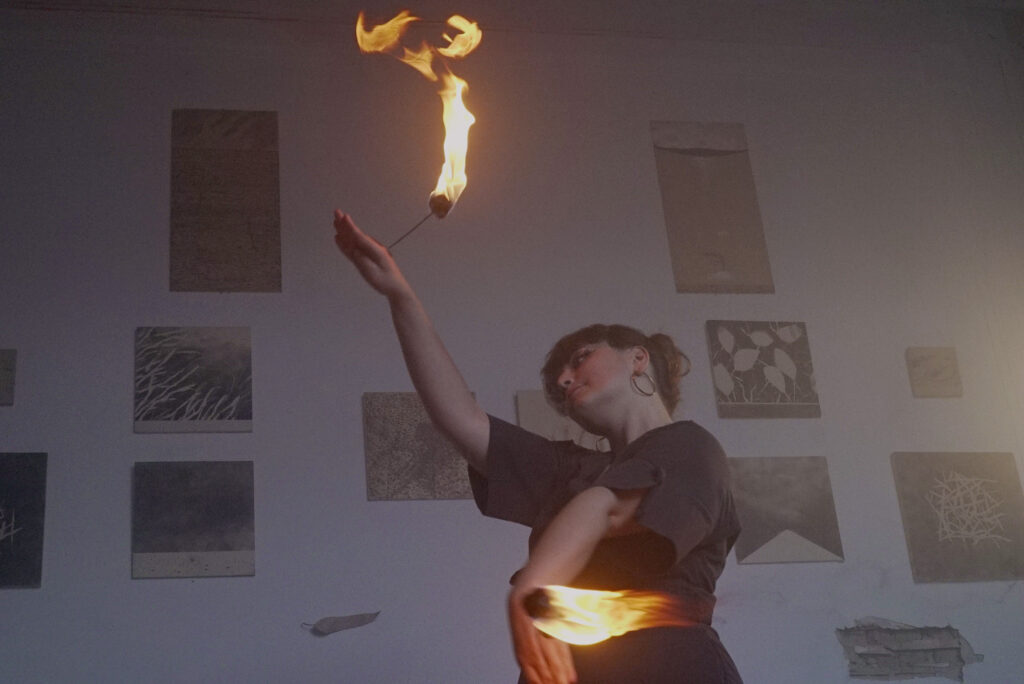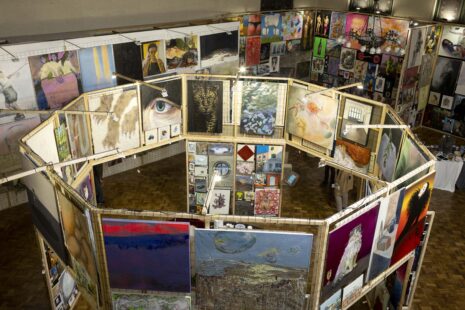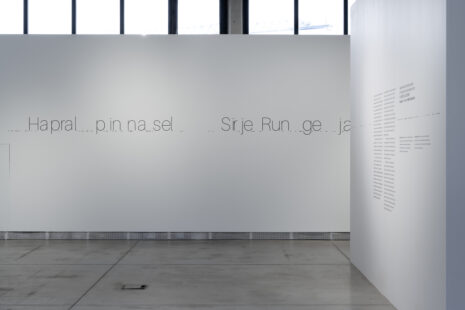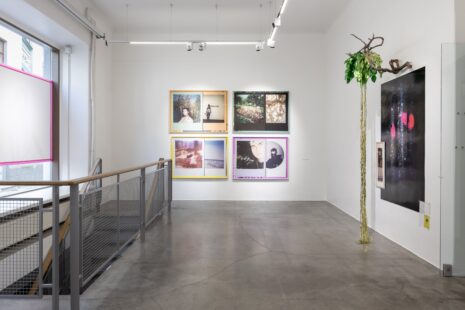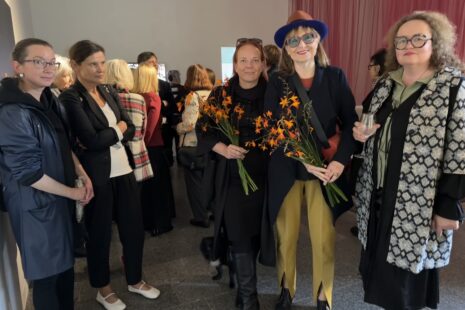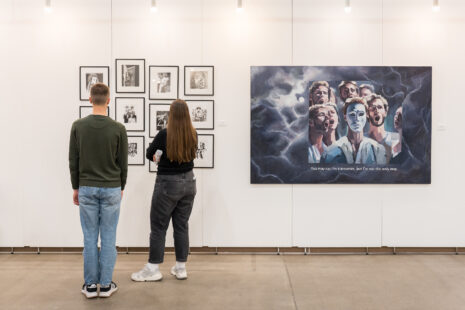Raituma’s artistic focus lies in exploring the sublime in nature and liminal spaces. She began developing this interest during her time in Portugal, where the striking contrasts between the ocean, cliffs, and forests of Sintra became an integral part of her creative process. Her approach often combines wood burning, painting, and organic materials, creating a powerful dialogue between natural and urban environments. Raituma describes fire as a “wild element” that she prefers to collaborate with rather than control, a medium that has brought new life to her art after she grew tired of traditional oil painting.
In addition to her personal practice, Raituma is deeply committed to creative placemaking and community engagement. She values the role of art as a living dialogue and has involved local communities in several of her projects. From co-founding the ‘Riga’s Highest Gallery’ to teaching her fire techniques in workshops, she continuously seeks to connect with others through her work. Her residencies in Portugal, including at PADA Studios and OSSO Residency, have been pivotal in developing her distinct approach.
Reflecting on her international experiences, from the cultural richness of Venice to the artistic vibrancy of Lisbon, Raituma continues to push the boundaries of her practice. While deeply rooted in her Latvian heritage, her work speaks to a broader exploration of universal human and natural connections.
Can you tell us more about your journey as an artist? What initially sparked your interest in visual arts, and how did it evolve over time?
My artistic path started a long time ago, If I think about it – maybe it has always been there, growing and evolving together with me. I told my parents that I am going to be an artist already when I was 5 years old. I was particularly drawn to drawing and painting, had several private teachers and courses. After high school I enrolled in Art Academy of Latvia, I finished my bachelor’s and master’s degree there. For the past 4 years I have been working as an independent artist, actively practising and developing my practice, different mediums, techniques. The outcome of the creative force takes various shapes, yet it is something so integral for me, like a forever filter on my life.
You have studied at the Art Academy of Latvia and also spent time in Venice. How did those two experiences shape your perspective on art?
I see my study time at Art Academy as a great foundation, not only for the visual expression but also for the connections, for the critical thinking and understanding of profound research. Already in bachelor’s I realised that the Erasmus+ mobilities as a student are a great way how to travel, expand the cultural and visual conscience. Venice was like an explosion of art, such a concentrated essence. I was mesmerised and took the chance to visit so many exhibitions. However, Venice can be overwhelming with the number of tourists and the difficult living conditions, such as acqua alta(the high tide – seasonal floods). Yet I met a very nice artist there who started to teach me juggling with fire, it really got stuck with me and influenced the next turns in my practice. Venice is like that – so many surprises on every corner. And the Art Academy there has profound printmaking traditions, I really learnt a lot of that there too.
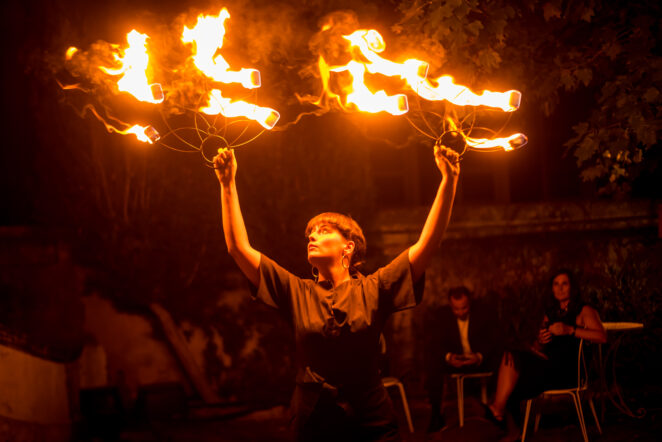
Photo from a fire performance in Lisbon
How has living and working in Lisbon influenced your artistic practice compared to your time in Latvia?
Lisbon has been a very long chapter for me, something that I maybe did not initially expect. Well, apart from this city being a major inspiration with its unique light, tiles and hilly roads, it also was my shelter during the pandemic years. That is when I started to love hiking – going to cliffy, deserted beaches, swimming in the roaring ocean, wandering through the green jungle of Sintra (to note, it is such an enchanted location. The famous fairy tale author H.C. Andersen has lived there!). So yes, I love Lisbon’s proximity to the ocean and forests, that has helped me to gather materials and capture many sublime memory-landscapes. As of the city’s art scene, it is very vibrant and international. This vivid, bubbling atmosphere has left an impact in many ways, I have had the opportunity to take part in many art residencies, work at a gallery, experience fairs, curate and exhibit.
Your work frequently explores the sublime in nature and liminal spaces. Can you elaborate on how these themes became central to your work?
This focus point of my artistic research evolved in 2020 when I arrived to Portugal, completed my first art residency there. Later on, I developed these themes in my master’s thesis. I felt like living on the borderline myself. To explain briefly, the liminal space is between ‘the inside and the outside’: an individual and his surroundings, the man-made and nature. The anthropological notion ‘liminality’ or the ‘threshold’ (first invented by anthropologist Arnold van Gennep) can be described as a space resulting from passage and transition. Also, a collective transformation that has occurred over a group activity. My interest also expanded into the research of the sublime. Philosopher Kant distinguishes two notions of the sublime: the mathematically sublime and the dynamically sublime. In the case of both notions, the experience of the sublime consists both of visual pleasure and ‘negative liking’ or a touch of fear at the same time. The irresistibility of nature’s power certainly makes us, considered as natural beings, recognize our physical powerlessness, but at the same time it reveals the inner strength of the spirit. How to get in touch with the sublime in oppressed, over-civilised conditions? For me the work with the element of fire became the answer, it freed me.
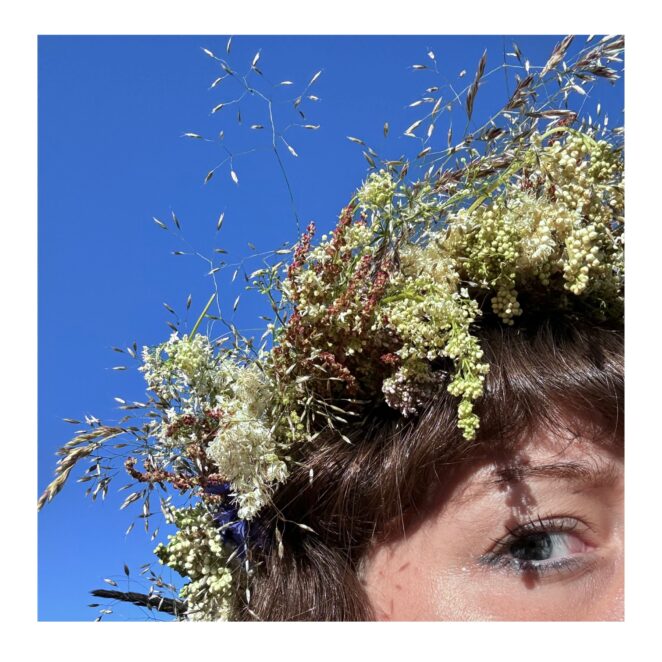
The use of fire and wood burning is a distinctive feature in your artwork. What initially drew you to this medium, and how has it evolved over the years?
The first push was my time in Venice that I mentioned before. Also, I grew bored of the classical painting with oil paint, I felt like I needed more challenge, something that I can discover and where I do not have certain guidelines. The interest of fire and its direct usage as an artistic medium developed through experiments and research for master’s thesis. Eventually, I developed techniques that are unique. Of course, I have had my historic influences like the practice of Italian artist Alberto Burri or the surrealists, yet what I have come up with is still different, and what more, I feel like I am still discovering new technical approaches. I think I can say that over the years I have learnt to get rid of the excess, I am aiming for a certain simplicity that embodies a wholesome essence – it is like peeling off the layers to get closer to the core.
How do you balance the use of organic materials and natural elements with your installation work? What message do you hope to convey through this combination?
This often is a very intuitive process; I especially like making on-site installations when I am at an art residency. For me, it is like an indication of the special features of a particular environment, something raw and truthful that is present right there in that time and place, plus, something purely natural that is like a coexisting presence together with the other artworks that I have made. I feel that it helps to contextualise, to honour a certain season, climate, plant species, also to draw attention to the more-than-human world. Which means, it guides to a certain plant-thinking rather than just human-thinking with the rational mind.
Your work often examines the relationship between urban and natural environments. How do you approach this topic, and what does it reveal about modern life?
I approach it from a rather personal standpoint, meaning that I immerse myself in these different environments, be it a studio in the city or a residency in the countryside. I research the area, work with the materials around, examine the types of relationships. I try to involve local people, gather opinions. It reveals the diversity of life, there are symbiotic, collaborative yet also invasive relationships coexisting. And I think that the specific aspect of the modern life is that throughout a single day it is possible to witness and be involved in so many kinds of these relationship – it is the saturation of experiences.
Can you tell us about your creative process, especially when working with such contrasting materials as fire, wood, and organic matter?
My creative process usually starts with the research, be it exploration of the area, reading books on the particular topic. Afterwards, I tend to make compositional sketches, document, write down observations, feelings. When it comes to wood burning, I experiment with the techniques that I have developed. In short, I use candles, matches, for bigger pieces also a gas torch. A hazy, nuanced visual effect can be achieved by the symbiosis of the flame and organic surface, the color can vary from light grey to black. The very detailed parts I carry out by using a pyrograph, a wood burning tool that allows to ‘draw’ onto organic surfaces. This tool is a pen-like device with a metal end, through which heat is transferred to a removable nib. I also tend to work by layering, something that I carry with me from oil painting times – it is like glazing but instead of translucent layers of paint there is fumage. And then there is always room for the unpredictable – I allow the creative process to guide me, plus, fire is a wild element, so I like to cooperate with it rather than control it.
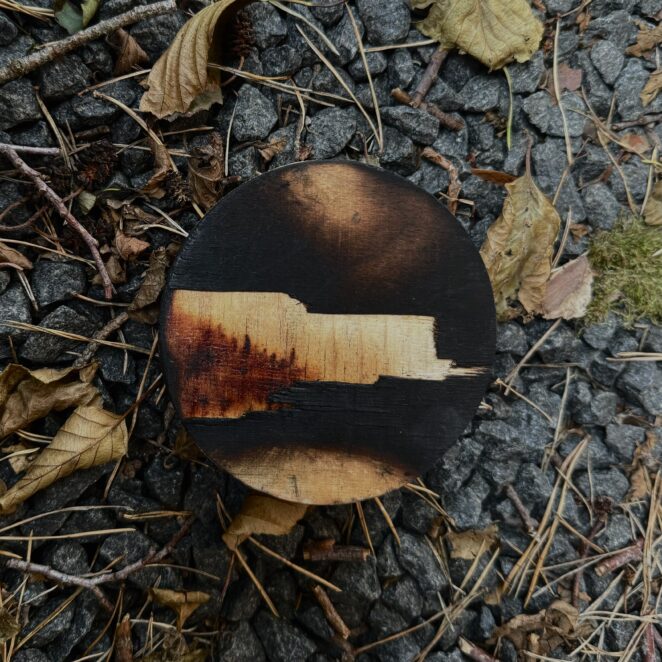
Work in process, outdoors
You’ve been involved in creative placemaking and community-engaged projects. How important is the relationship between art and community to you, and how does this influence your work?
This relationship is crucial – art does not exist in the vacuum. It is a dialog, or rather a polylog, between the artworks and the people who see them. The pieces that would be just inanimate objects come alive and vibrant when they become a focal point of a conversation. Therefore, I really try to showcase my works, not necessarily at an exhibition, rather sharing both the process and the final pieces with the community: friends, collaborators, supporters. It is often the feedback that change a certain direction of the process. Moreso, for the past two years I have also been holding workshops teaching my fire techniques to people and it is remarkable how innovative even a non-contemporary art related person can get when exploring completely new materials (For instance, I was taking part in the ‘Largo’ residencies project in Lisbon working with people in a refugee status). Therefore, not only I teach but also learn a lot from others, it sort of becomes one organism, and it is the most rewarding feeling for me.
What inspired you to start ‘Riga’s Highest Gallery’? What role do you think independent art spaces play in today’s art ecosystem?
I founded ‘Riga’s Highest Gallery’ together with artist Linda Vilka in 2021. Back in the time for a brief period we were flatmates and studio neighbours at the same time, and it was so frustrating to us that due to the pandemic restrictions, it was not much possible to showcase our works. Therefore, we opened this space in our apartment, and, to our surprise, so many culture-related people visited it! These kind of independent art spaces are the heart and soul of the art ecosystem; I would dare to say that they are the most unique and raw since they are not so white-cubbish, not so focused on particular sales.
Your recent solo shows in Portugal, such as “May Home Stay Within You” and “Axis Mundi,” have received positive attention. Could you share the inspiration behind these exhibitions and the process of creating them?
“May Home Stay Within You” was my solo show at PADA studios in Barreiro in 2020 where I showcased works developed during my art residency there. I was exploring the notion of ‘home’ since the pandemic was going on and ‘home’ gained a new meaning. The exhibition served as a poetical and surreal proposal of a viewpoint to home as an interspace, a boundary line of the inner and outer, a fragile mark between life and death and an insight of the impact of natural cycles onto all the homes. During the residency I mainly worked with birch plywood as a Nordic representation and plants growing in Barreiro as a Southern portrayal, developing paintings and installations. Additionally, the exhibition included a video documentation of my performance in the area of the Industrial Park, a very unique space in Barreiro.
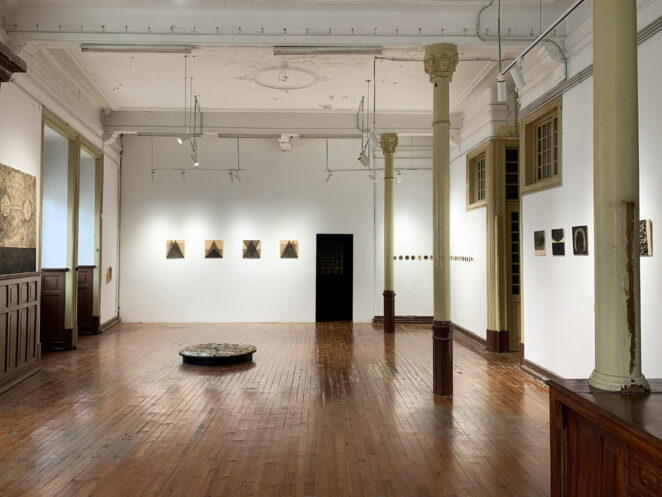
Solo show ‘Axis Mundi’ in Lisbon, 2023
“Axis Mundi” was my solo show that took place a year ago at ‘MAD Marvila’ gallery space in Lisbon. In many early cosmological systems, ‘axis mundi’ serves as a link that interconnects the celestial and the terrestrial – the two poles, manifesting in various symbols, such as the Tree of the World, the rotation of a sphere, or a column of fire and smoke. The concept of a cosmic pillar has long been applied to bridge the past and the future, embodying the possibility. Therefore, the exhibition explored the dimensions of the contemporary axis, questioning whether the center has remained intact. How have both the individual and the Earth itself been delineated by the pressure of concurrent global processes, how sustainable, enduring, and linear is the actual flow of everyday actions and responses.
For this exhibition I dissected both inner and outer core landscapes through a series created with my fire techniques, using this primordial element of change to burn wooden panels. My aim was to transcend both time and space, guiding along a shared axis that also intertwined video and documented performance pieces.
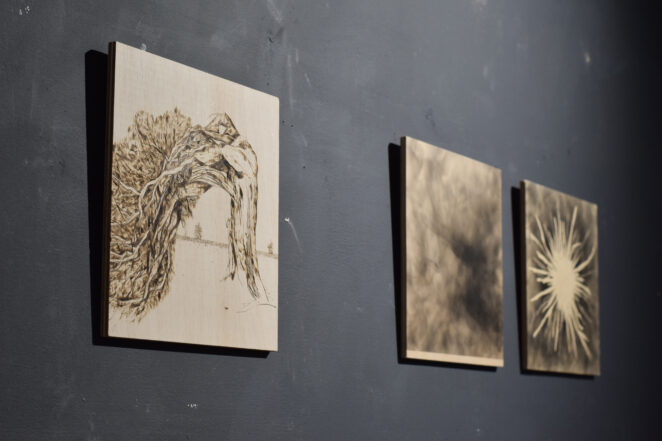
Solo show ‘Axis Mundi’, Lisbon, 2023
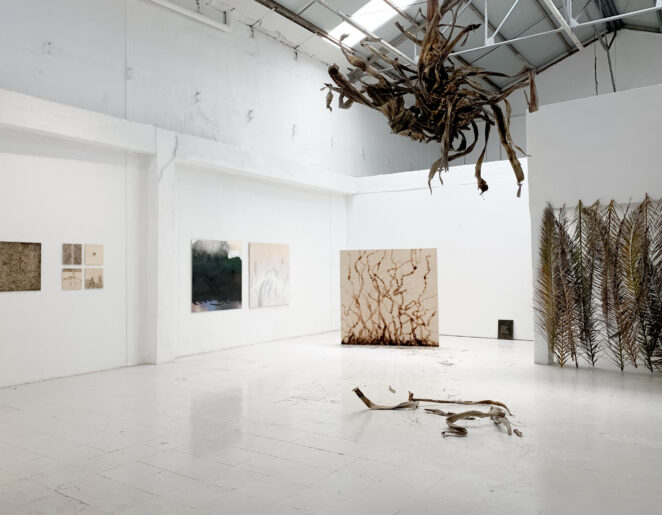
Solo show ‘May Home Stay Within You’, overview’, Barreiro, Portugal
Your artwork “Nucleus. Contraction” and “Nucleus. Expansion” are highly symbolic. Can you talk more about the meaning behind these pieces and their connection to inner strength and growth?
These works reflect on the sense of the core, “Nucleus. Expansion” is for the feeling of gathering strength within and breaking open afterwards. It is about the expansion of good intensions, the power to reach all the goals, to multiply and merge with all the greatness around – a burst of pure energy, almost like an exploding star. Whereas “Nucleus. Contraction” reminds of the feeling of going inwards into a self-center, gathering power from the origins. This diptych reminds us that growth is not exactly a linear path, there are ups and downs in energy. And calm, restful, reflective times are needed to be able to prepare for the active periods. Like the seasons throughout a year, in a way.
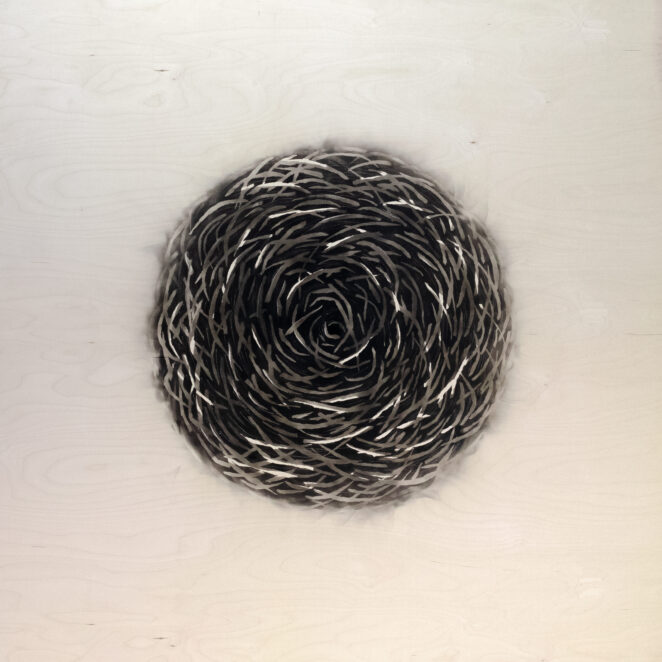
Nucleus. Contraction, 2023. Burnt plywood, 125 x 125 cm, €2080
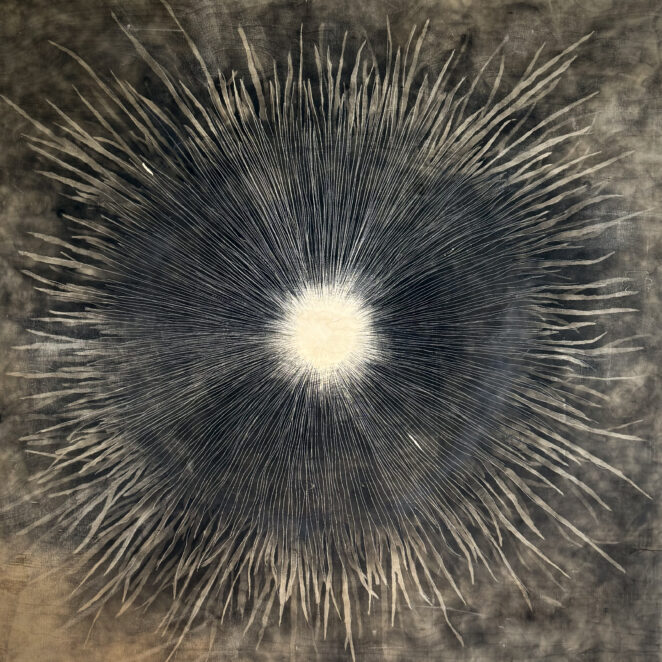
Arta Raituma. Nucleus. Expansion, 2023. Burnt plywood, 125 x 125 cm, €2080.
You’ve mentioned that routine and comfort can stifle creativity. How do you keep your artistic impulse alive in times of stability?
I guess it goes in cycles. For example, after very intense exhibition times, there have to be calmer periods when a certain comfort and a simple routine are a must for regeneration, recollection (The exact message that I would like to pass with my works “Nucleus. Contraction” and “Nucleus. Expansion”). And the artistic impulse is more like a muscle – of course, there ought to be a little pause when it is all sore. However, it is still the frequency that matters. It is about consciously making that time to take a pen and make a sketch, even if it comes out badly. Some things will eventually connect and make sense, just have to keep doing.
What role does mythology and symbolism play in your art? How do these concepts shape your storytelling?
Since my teenage years, I have been very drawn to the ancient Baltics mythology as well as exploration of animism, belief systems in indigenous cultures. I guess I like to soak these stories in like a sponge, to allow my subconscious to cook them internally, connect and reveal visually when the time comes. I like to have double meanings, something that people can read between the lines if they have the will and the eye. Aren’t we all looking for a pinch of the mythical and mystical?
Looking back, what has been your most significant or personal artwork to date, and why?
It is very difficult for me to highlight one work only, or even several, as the most significant. I am a big believer in the processual, and since the final pieces are like a finished product, I have learnt to detach from them, to let them live their own separate lives. So the ones that are yet not made but already exist in the thoughtform, those would be the most significant currently! As for the most personal, those could be some of my self-portraits that I am keeping in my archive or that belong to my family.
What are your upcoming projects or exhibitions that you’re excited about? Any new directions you’re exploring artistically?
I am quite excited about my current exhibition, a group show ‘Campfire’ organised by ‘Myma’ collective, in New York. I hope to get more immersed in the Baltics scene as well. And then there are some brand-new directions – I am planning some possible exhibitions in India. For the past year, I have also been working in filmmaking so there are some pieces cooking in a video/film format.
As someone who has lived and worked in different countries, how do you see your artistic voice evolving in the future, and what role do your diverse experiences play in this evolution?
These experiences have given me the understanding of interconnectivity. I can see myself expanding more across different countries, searching for those universal visual keys that unite us as human beings, that help to connect with also the more-than-human world – the plants, the natural elements. I would like to reach more eyes and ears exponentially, which means doing a lot of things online also – so that it is more accessible to everybody.
I think that empathy, resilience, flexibility and openness are those characteristics that living abroad has infused. Therefore, I would like to expand in sharing my practice, teaching, mentoring, involving people as many ways as possible – spreading that creative flame.
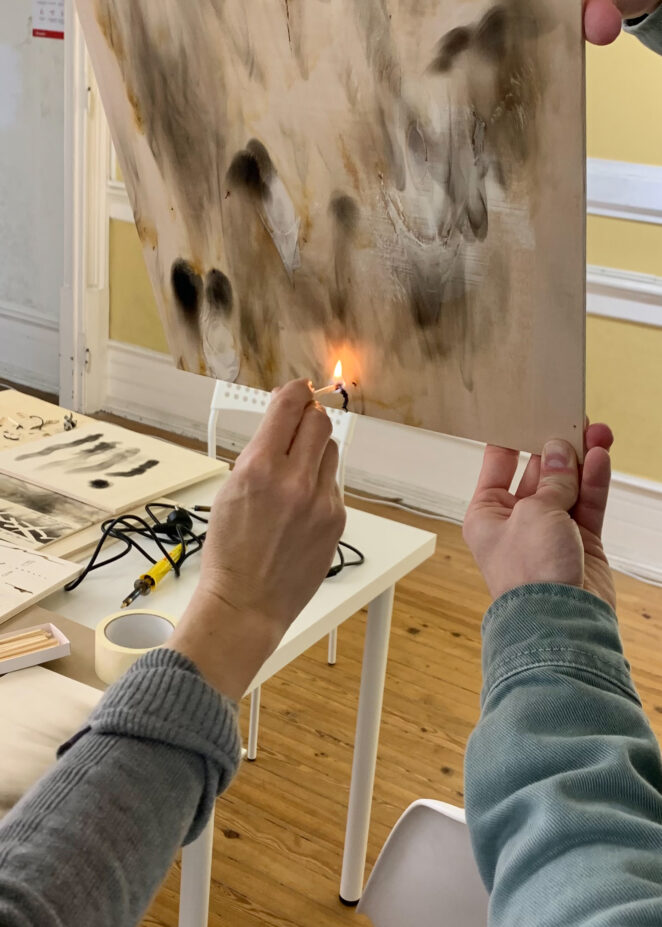
Teaching fire techniques – photo from a workshop

